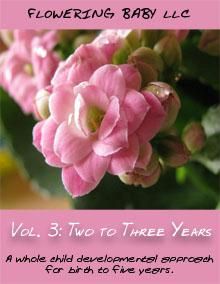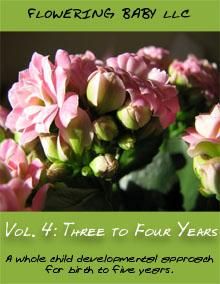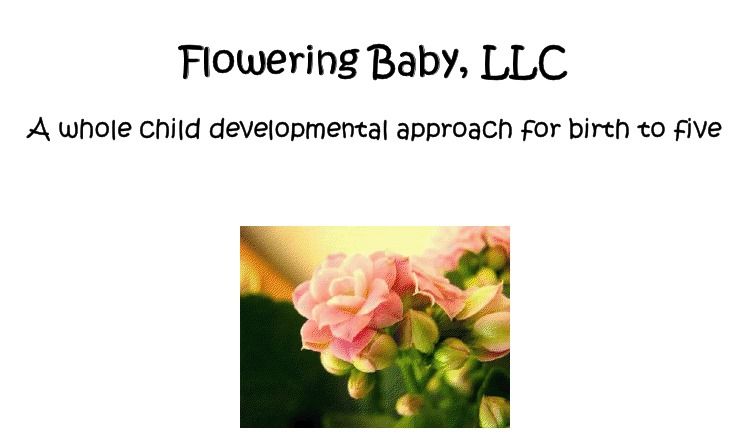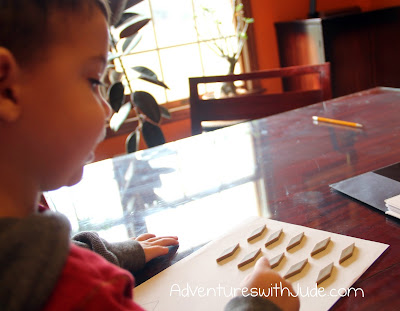 I do not believe that two year olds really need a formal curriculum. However, "Here is a crayon, go ahead and color," is not impressing Damien, and letting him wander about while Jude was working is quickly becoming a recipe for more housework. By September, Jude will reach "mandatory school age," so I have been focused on getting a good foundation laid for him so that we do not have trouble meeting the state's expectations this fall rather than keeping Damien entertained. I was interested in having a program that would help find activities to keep Damien occupied but did not require me to do an excessive amount of prep work or actual teaching. I was very excited to try Flowering Baby, LLC's program, because it claimed to be a fun, developmentally appropriate, and low-prep early learning system. One very appealing part was that it appeared the program's
only prep requirement was "gather materials listed and follow the activity
manual." I received a copy of the entire curriculum (CD-ROM, $132), and set my focus on the syllabus for the Two to Three year old program (available as an individual CD for $30).
I do not believe that two year olds really need a formal curriculum. However, "Here is a crayon, go ahead and color," is not impressing Damien, and letting him wander about while Jude was working is quickly becoming a recipe for more housework. By September, Jude will reach "mandatory school age," so I have been focused on getting a good foundation laid for him so that we do not have trouble meeting the state's expectations this fall rather than keeping Damien entertained. I was interested in having a program that would help find activities to keep Damien occupied but did not require me to do an excessive amount of prep work or actual teaching. I was very excited to try Flowering Baby, LLC's program, because it claimed to be a fun, developmentally appropriate, and low-prep early learning system. One very appealing part was that it appeared the program's
only prep requirement was "gather materials listed and follow the activity
manual." I received a copy of the entire curriculum (CD-ROM, $132), and set my focus on the syllabus for the Two to Three year old program (available as an individual CD for $30).Note on pricing: The author has offered review readers a 10% discount when purchasing directly through her website www.FloweringBaby.com. Please use the promotional code Blog10.
Each month is divided into 20 lesson days (4 five-day weeks of "classes"). There are usually eight activities planned for each day. At least two are passive from the child's perspective: reading and listening to classical music (each month has an musician-of-the-month as suggested listening). If you have a child who likes music at nap or bed time, this would be a perfect opportunity; a rest time story would also complete the "read this book" activity. Others are a hybrid of daily activities (snack and meal time) where you use the object to demonstrate concepts (ie, 10 yellow goldfish for snack; 10 red strawberries are used for a smoothie). Other activities, such as fine motor skill practice (cutting, coloring) and gross motor movement (jumping, running, walking) are combined into fun activities (creating a craft, walking through the woods).
 |
| iTunes |
As much as I love the concepts of the program, and the music study in particular, there were three big problems for us.
First, while samples of plans are offered on the program's website, it is difficult to discern the skills needed to be successful over the course of the entire year. Because Damien is 2 1/2 years old, we were able to refer back to some of the "young 2 year old" activities for ideas to help with those skills he is weak in. However, if he were closer to his second birthday, we would be at a loss because we wouldn't know where to look for holes in the foundation. I think there is potential for an advanced/older child to be bored, and he might benefit from starting the three year old program early. Knowing what skills are expected for the start and specifics goals for the end of the year would help a parent determine precisely which level is most appropriate the child, rather than basing the purchase decision on a child's age.
Our second problem was starting with it mid-chronological-year, and in winter. The introduction page of the Flowering Baby site states that you can start the program at any time, but our experience says this is not quite the whole truth. Even if you start at the beginning of the month of age, concepts taught sometimes span two months and you may find yourself starting mid-course. Despite Damien actually being chronologically 29 1/2 mos old when he began, we started at the beginning of the month because it was very confusing to just "drop in" on day 11. Even going back to the beginning of the month, there were still parts that seemed awkward. For some activities, it may not matter where you begin - for example, counting from 1 to 10 is from 1 to 10, no matter if you start it on the first day it's introduced, or the 20th. However, one of the language skills presented in the third year is learning the alphabet. It can be confusing to start singing an alphabet song yet practice writing with a mid-alphabet letter (as happened to us). I think it might make more sense to say that "The program allows you to generally begin at any point, but you may need to adjust some activities to a more natural starting point." Or, the program could be adjusted so that a "cycle" of something runs through the course of one month, so that a family beginning at the start of a month will not feel like they missed something. In addition, the activities are meant to complement the developmental year, not necessarily the calendar year, yet may be weather dependent. Clearly, sometimes weather doesn't cooperate and you can swap activities, but there's not much you can do outdoors when the temperatures are in the single digits for almost two weeks running.
 |
| Damien's Tubey Monkey, Mr. Mookey. Mr. Mookey says, "Please do not feed me, I have food allergies." |
 |
| Some non-food manipulatives we used. |
Month 29, Day 2
Math concepts: Count from 1 to 10, skip count by 2’s. It is even more reinforcement if you do the skip counting with some sort of manipulative. You can use small crackers, Cheerios, or really any finger food.
Color of the day: Blue. Play “I spy” something blue today.
Shape of the day: Circle. Gather various items around the house that are round. You might find
a ball, a plate, a plastic lid and then try to roll each item in turn. Ask your child “Which items is
the largest?”; “Which items roll?”; “Why do you think some don‟t roll as well?”
Math concepts: Count from 1 to 10, skip count by 2’s. It is even more reinforcement if you do the skip counting with some sort of manipulative. You can use small crackers, Cheerios, or really any finger food.
Color of the day: Blue. Play “I spy” something blue today.
Shape of the day: Circle. Gather various items around the house that are round. You might find
a ball, a plate, a plastic lid and then try to roll each item in turn. Ask your child “Which items is
the largest?”; “Which items roll?”; “Why do you think some don‟t roll as well?”
We sorted out ten blue figures and
played with them for a little while.
Blue spheres roll away if you're
not careful!
We started playing with them on the bucket lid to keep them corralled.
We then were able to skip-count by twos with a visual of how many "ten by twos" is.
Damien learned that sometimes you can balance a sphere on top of a cube,
but often it rolls off no matter how carefully you place it.
but often it rolls off no matter how carefully you place it.
Damien picked all the balls out of the bin, and played with them on the lid.

Some days, rather than focusing on one shape or color, we pulled out a matching game for something new to do. Damien would tell me the shape and color on the small card, and then match it to his lap board. Jude sometimes would want to play along with us, thinking we were playing a Bingo-type game.
An activity from Month 30, day 2, with the focus on diamond shape as a shape, and learning how two adjacent triangles can create a diamond.
Blue diamonds...match two green triangles made into a diamond.
Staying with the diamond theme for manipulatives, counting with ten brown diamonds.
There was one developmental activity that I strongly feel needs expansion. From Month 30, Day 10:
Language: Observe your child to determine if he is using intelligible words at least sixty five percent of the time. If he mispronounces words you should repeat them in the correct pronunciation. You might be able to understand everything he says so this task is often best determined by watching him talk to strangers and evaluating if they understand most of what he says.

Because the Age Three to Four program ($38) is more unit-based, I was hopeful that maybe we could just set aside the Two-to-Three program and try to do some activities from there. Unfortunately, I do not think that program will suit us, either. Again, the program depends on both average skill development and lots of food, so it will not be something useable for us in its published form. It would take a lot of effort to transform it into something Damien can do; honestly, I think I'd rather spend the time looking at other programs.
I do believe that the program's spiral presentation is good for mastery. Damien definitely has learned and solidified many concepts. He now can reliably count backward from 10 and forward to thirteen, and often attempts the rest of the "teens." (Usually in the wrong order, and with a few extra numbers for good measure -- "Zeroteen" anyone?) He can also identify a combined fourteen 2- and 3-dimensional shapes and eight colors. I'm not certain if this is developmentally appropriate for a two and a half year old or not, since none of his siblings have reached milestones "on time" (all five children have had developmental delays), but I'm his mom, so I get to think he's a genius, right? I have noticed that while his pre-writing skills are still abysmal, his occupational and feeding therapists have remarked that his grip a crayon and a spoon have started to become more refined. He still often holds the implements in his entire fist, but a more mature tripod grasp is beginning to emerge.
Time is valuable; I know when Jude first started homeschooling I spent up to two hours each week putting together developmentally appropriate preschool lessons. Even accounting for any basic supplies (crayons, paints, puzzles, a few recommended CD's), the program's cost is very modest for a year (or five) of daily lesson plans. I had hoped the Two-to-Three program would be of use to us; the Three-to-Four program would have been a nice transition to a more formal PreK-4 curriculum. Unfortunately, with the way the program is arranged, I still had to set aside several hours revamping the program to fit our needs. While we both enjoy the one-on-one school time, it doesn't keep Damien occupied busy while I help Jude. As much as I wanted to like the Flowering Baby program, it just wasn't right for us.
Disclaimer: I received a free copy of the Five-Year Curriculum as a member of the TOS Homeschool Review Crew, and I received no other compensation. In exchange, I agreed to give an honest review of how this program worked for our family.
There are lots of other newly minted preschoolers this winter.
Click the banner to see what their parents thought of the Flowering Baby lesson plans!












Meg,
ReplyDeleteThanks for a very thorough review. Perhaps it may help the vendor come up with alternative suggestions for different situations. You spent a lot of time on this - thank you very much!
Warmly,
Kate